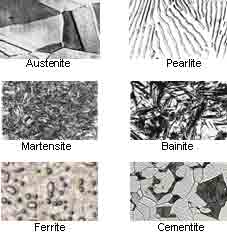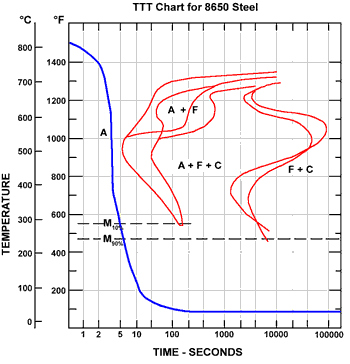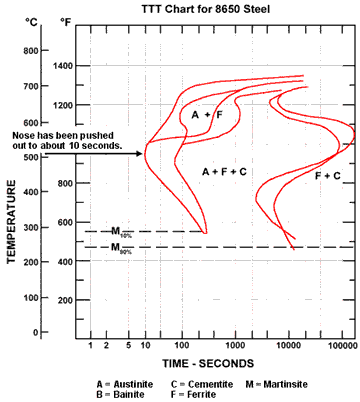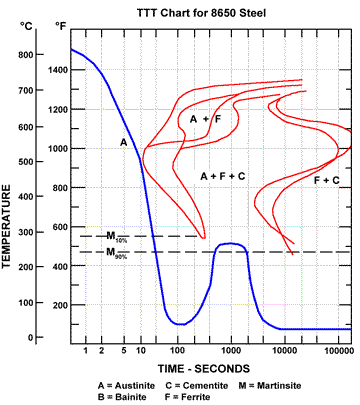 |
|
| Grades of steel |
|
Austenite, Pearlite, Martensite, Bainite, Cementite, Ferrite, and combinations of these, can all be produced by varying the quenching cycle. Note that as steel is cooled over a longer period of time, instead of forming a nearly pure Martensite - Pearlite, Bainite, and other crystals are created in addition. The cooling curve in the chart on the right was not nearly fast enough to form the high percentage of Martensite a toolmaker would like to have. |
|
Notice that the nose of the graph is at about 5 seconds. This means there is only a few of seconds over which the cooling must be completed. Accomplishing this could be impractical or even impossible. A second problem also exists. Even if one were able to cool the steel this quickly, a fast rate of cooling would create a great deal of stress within the steel and also cause distortion of the steel as it attempts to relieve the stress. Twisted, unstable, and very brittle steel would be the unhappy result. Somehow the amount of time available for cooling, needs to be extended. |
|
The benefits of the element chrome are obvious, but as you would expect, each additional element also adds cost to the production. One final factor that has a great affect on the quality of the steel, is variation in temperature within the furnace. In order to control grain growth, grain size, and hardness, the furnace must maintain very consistent temperature throughout. Bondhus is the only company that adjusts its furnace temperature to match the exact composition of each steel heat number. It should be noted that the TTT chart is very different for every grade of steel, and it even varies on the basis of elements that are added to the mixture. In other words, the more precisely the composition of the steel is monitored, the more accurately the quenching and tempering adjustments should be. Because Protanium® Steel has the tightest specification in the industry, Bondhus is able to achieve a level of quality and consistency none of its competitors are able to come close to. As mentioned earlier, Martensite is extremely hard, but it is also very brittle. In order to assure hardness and good ductility, the quenching cycle must be followed by tempering. The process of tempering involves reheating the steel to a temperature below the transformation range, holding that temperature for a given period of time, and then cooling. |
|
Science or art? Adding certain elements to steel, in the right combination and precise quantity, produces many desirable effects as well as dramatically altering the TTT chart. The result is a more attainable cooling rate and higher quality steel that conforms closely to the specification being sought. Heat treating and quenching is an exacting process. It takes a great deal of knowledge, experience, equipment, and trained personnel to consistently produce the desired results. Bondhus has more expertise than any other competitor in the marketplace. Each heat treating technician at Bondhus has over 400 hours of training in the production of Protanium® Steel, and an average of over fourteen years of experience producing it! |


 The cooling
curve shown on this chart for 8650 steel accomplishes the
objective – a fairly pure form of Martensite. There is still a
problem however.
The cooling
curve shown on this chart for 8650 steel accomplishes the
objective – a fairly pure form of Martensite. There is still a
problem however. By
adding
By
adding 